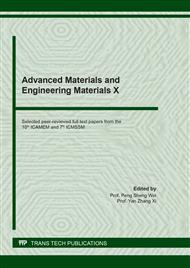p.3
p.9
p.14
p.20
p.26
p.31
p.39
Experimental and Numerical Examination on Formability and Microstructure of AA3003-H18 Alloy in Single Point Incremental Forming Process
Abstract:
The single-point incremental forming process has witnessed significant advantages in automobiles, aerospace, and medical applications in recent years because of its flexibility in manufacturing complex shapes. In detail, the components are produced only using the toolpath, which is guided by computer-aided manufacturing software. However, during the forming process, the parts might experience fractures, which could heavily impact the formed part's geometric accuracy. The main purpose of this study is to analyze the formability of an AA3003-H18 aluminum alloy material in the SPIF process; for this purpose, the material properties are extracted from the experimental simple tensile test in three directions corresponding to the material rolling direction. At first, a simple tensile test is modeled and estimated the material properties for conducting the numerical simulations. Second, the real-time experiments of the SPIF process in terms of predefined forming conditions are performed, and then the surface roughness was measured to check the surface quality of the formed parts. Then, the formed parts are scanned using a 3D ATOS scanner and compared against the desired computer-aided design (CAD) model. Eventually, the numerical results are discussed in comparison with the experimental outcome and displayed a significant correlation toward the expected results. This results comparison communicates that the introduced finite element (FE) model can be adopted for investigating the appearance of thinning location, thinning reduction, distributions of stress and strain. The overall results show that satisfying material formability in better surface finish and geometric dimensional accuracy can be accomplished when the forming conditions are designed appropriately.
Info:
Periodical:
Pages:
14-19
Citation:
Online since:
November 2021
Price:
Сopyright:
© 2021 Trans Tech Publications Ltd. All Rights Reserved
Share:
Citation:


